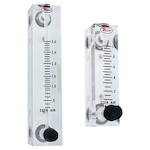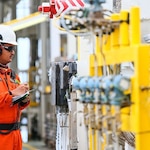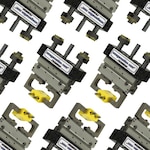Semiconductor transistors are extremely small electronic components whose conductive properties can be precisely controlled. This ability to switch and amplify electrical signals is what makes them the foundation of the microchips used in everything from smartphones and computers to industrial, automotive, and medical systems. Because modern transistors are manufactured at nanometer-scale dimensions, even small variations in the environment can disrupt processing—which is why semiconductor fabrication requires extremely strict environmental control.
Semiconductor Fabrication Facilities: A Breakdown
A semiconductor fabrication plant (“fab”) is typically organized into several vertically stacked levels, each with a specific role in the manufacturing process. Across all of these zones, precise regulation of pressure, airflow, temperature, and contaminants is essential. Proper differential pressure prevents particulate backflow, stable airflow ensures uniform filtration and exhaust, and tightly controlled temperature/humidity maintains process stability for lithography, deposition, etching, and other critical steps.
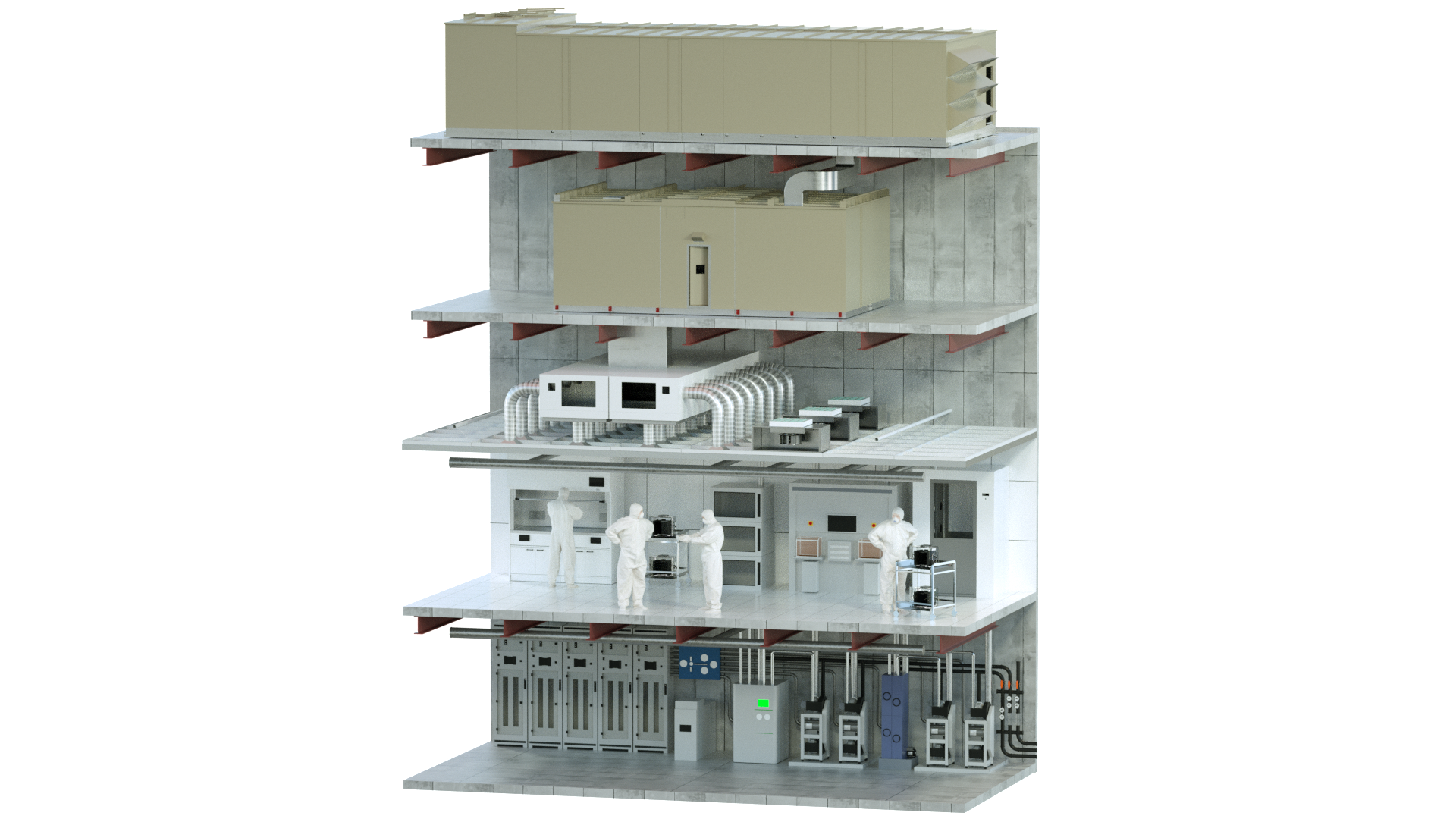
Cleanroom (main process floor)
This is where wafer fabrication occurs. The cleanroom maintains ISO-classified particulate limits using continuous HEPA or ULPA filtration and carefully regulated humidity, temperature, and airflow. Most process tools are located on this level, and the environment must stay extremely stable to support lithography, deposition, etching, and other precision steps.
Subfab (directly below the cleanroom)
The subfab houses the mechanical and utility systems that support the tools upstairs — including vacuum pumps, abatement systems, chillers, exhaust ducting, and process gas distribution. Positioning these systems below the process floor reduces vibration, heat, and noise inside the cleanroom while simplifying maintenance and equipment access.
HEPA Room / Fan Filter Unit (FFU) Level
Above the cleanroom is the airflow plenum or HEPA room, where fan filter units push filtered air down into the process area. This level ensures a uniform vertical laminar airflow, maintains positive pressure relative to adjacent spaces, and continuously removes particulates generated during processing.
Support Level (mechanical / utility systems)
This upper or adjacent level typically contains major building systems such as HVAC make-up air handlers, scrubbers, chemical delivery infrastructure, and facility-wide filtration and exhaust equipment. These systems maintain the environmental stability and contamination control the cleanroom depends on.
Understanding the Subfab Environment
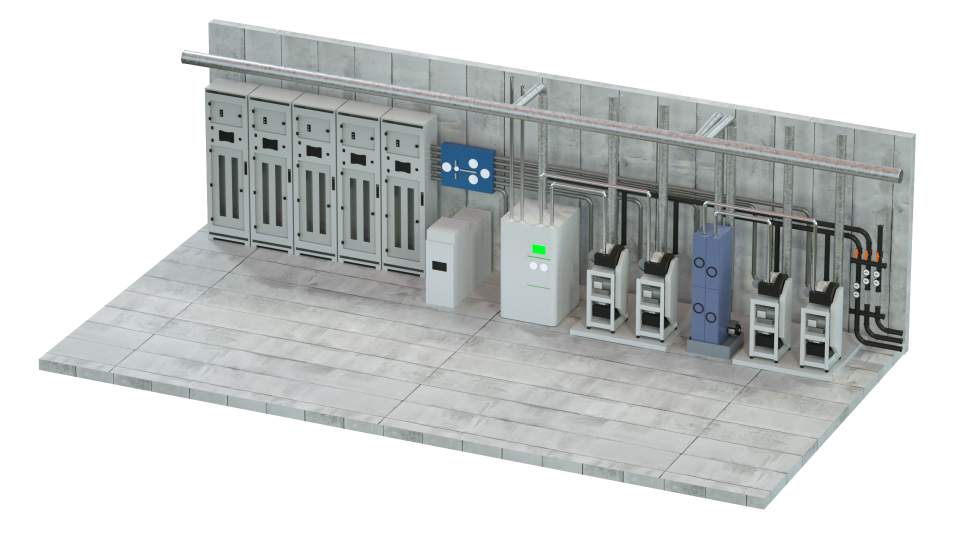
The subfab houses the critical support infrastructure that keeps cleanroom processes running smoothly. Vacuum pumps, chillers, gas cabinets, abatement systems, and other auxiliary equipment in the subfab interface with the process tools in the cleanroom above. These systems handle exhaust, gas delivery, cooling, and waste management.
Because the subfab connects mechanically and pneumatically to the cleanroom, any deviation in flow, pressure, or temperature can propagate upward, disrupting wafer processes or creating contamination risks. Effective monitoring solutions allow for detection and correction of these deviations in real time.
Pressure Control in the Subfab
Pressure is one of the most tightly regulated parameters in semiconductor environments. A semiconductor fabrication facility typically operates with a carefully designed pressure cascade: the cleanroom is maintained at a slightly higher pressure than adjacent spaces, ensuring that airflow moves from clean to less-clean areas and preventing contaminants from entering sensitive zones.
In the subfab, this means maintaining negative or neutral pressure relative to the cleanroom and controlled exhaust zones. Pumps, scrubbers, and vacuum lines all depend on consistent differential pressures to operate efficiently. Even minor fluctuations in subfab pressure can alter airflow patterns, impacting contamination control and tool stability.
Flow Management in the Subfab
Flow control in semiconductor subfabs, also fundamentally essential, extends beyond air movement, it encompasses every circulating fluid or gas that supports production. Exhaust lines must carry away hazardous process gases safely and efficiently. Scrubber and abatement systems rely on consistent flow to maintain treatment efficiency and meet environmental regulations. Cooling water and chillers must deliver stable flow rates to prevent thermal buildup in pumps, compressors, and electronic equipment.
Inconsistent flow can lead to overheating, reduced vacuum efficiency, or inadequate exhaust removal, any of which can interrupt production or cause costly downtime. Monitoring flow stability across all critical circuits helps operators identify early warning signs of blockages, leaks, or pump degradation.
Temperature Stability in the Subfab
Subfab environments can generate significant heat from mechanical equipment such as vacuum pumps, blowers, chillers, and abatement units. Without careful temperature control, this heat can accumulate, creating hotspots that affect both equipment performance and cleanroom stability above.
Temperature variations also influence gas density, vacuum efficiency, and fluid viscosity—factors that directly impact flow and pressure control. As such, temperature monitoring is essential for predictive maintenance and process optimization.
Innovative Solutions from

Once the environmental control parameters of pressure, flow, and temperature are defined, the next step is selecting the right instrumentation capable of performing under demanding subfab conditions. Because semiconductor subfabs operate with a combination of clean air, exhaust gases, chilled water, and hazardous materials, monitoring devices must offer robust construction, precise measurement, and compatibility with modern control systems.
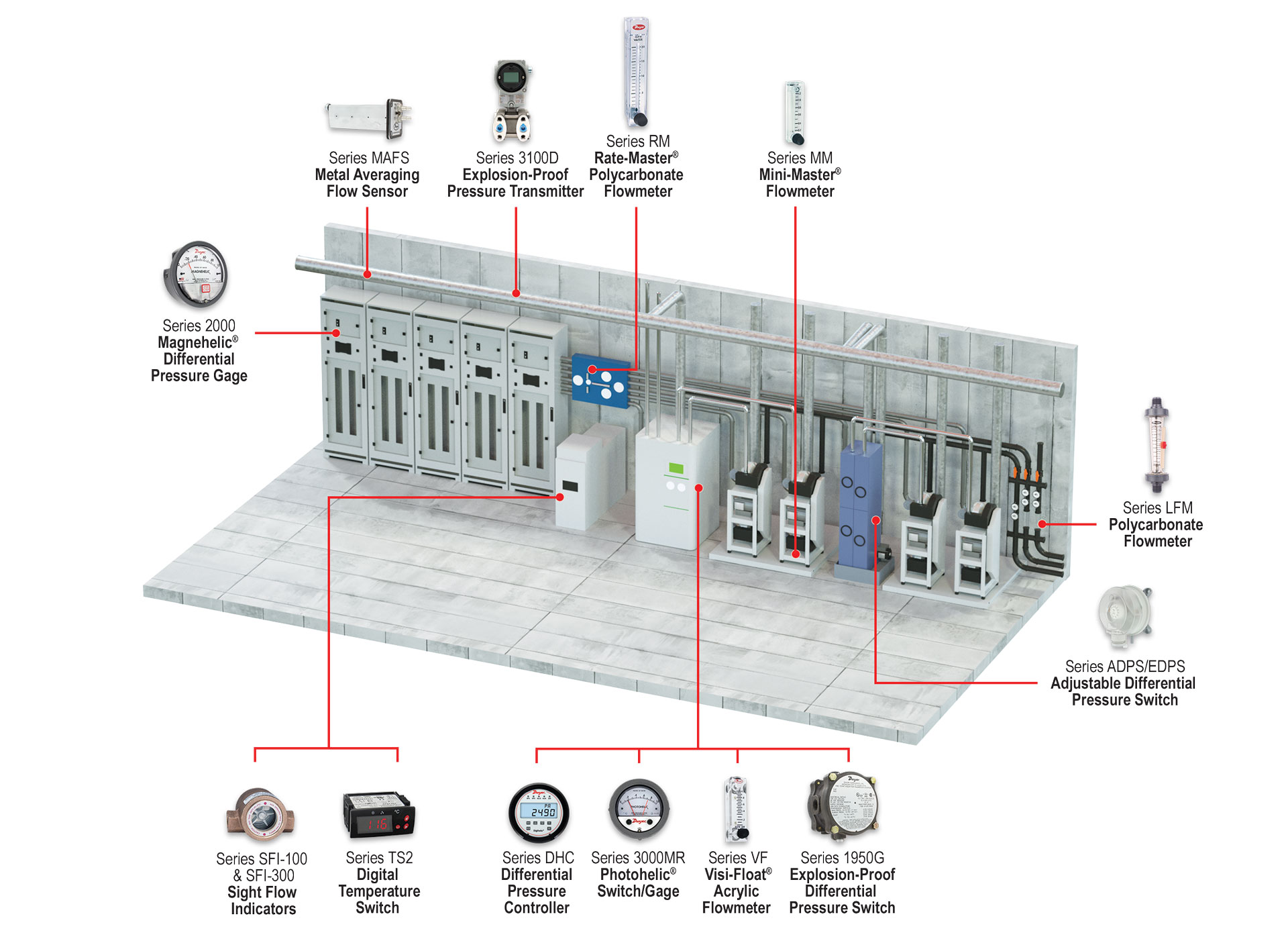
Pressure Monitoring Instruments
Maintaining stable differential and vacuum pressures between the subfab, cleanroom, and exhaust systems is essential to prevent contamination and ensure process stability. DwyerOmega offers a full range of pressure solutions—mechanical, digital, and explosion-proof—to meet every level of control requirements.
Series 2000 Magnehelic® Differential Pressure Gage

The Magnehelic® Low Differential Pressure Gage is a trusted analog standard that provides easy-to-read, maintenance-free measurement of low differential air and gas pressures—without requiring power. Its IP67-rated aluminum housing withstands dust and moisture, while the precision diaphragm and magnetic movement deliver fast, accurate readings ideal for cleanroom and subfab pressure monitoring.
Series DHC Digihelic® Differential Pressure Controller
The Series DHC Digihelic® Differential Pressure Controller is a versatile 3-in-1 instrument that combines a digital display, control relays, and transmitter output. The DHC offers 1.5 % accuracy for low pressure ranges, programmable 4–20 mA and voltage outputs, and Modbus®/BACnet communication. It’s ideal for controlling airflow, duct pressure, and volumetric flow within subfab ventilation and tool exhaust systems.
Series 3000MR/MRS Photohelic® Switch/Gage
The Series 3000MR/MRS Photohelic® Switch/Gage merges precise analog indication with reliable switch control. Its solid-state design allows for high cycle rate switching while maintaining continuous pressure indication, even during power loss. The Photohelic® is well-suited for pneumatic conveying, HVAC systems, and cleanroom air control applications.
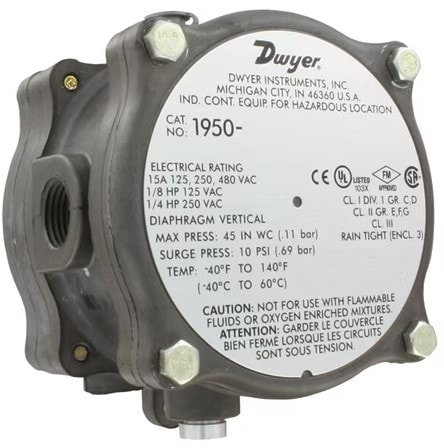
Series 1950G Explosion-Proof Differential Pressure Switch
The Series 1950G Explosion-Proof Differential Pressure Switch is built for hazardous environments and is UL, ATEX, and IECEx listed for explosive gas and dust atmospheres, as well as compatible with natural gas service. Its compact, rain-tight housing and easy-access terminals make it ideal for subfab process and exhaust systems where safety and compliance are paramount.
Series ADPS/EDPS Adjustable Differential Pressure Switch
The Series ADPS/EDPS Adjustable Differential Pressure Switch provides a cost-effective solution for monitoring air filters, duct pressure, and ventilation circuits. Its dual-scale adjustment knob allows quick setpoint changes in inches of water column or pascals without tools or a pressure gage. Compact, UL-rated models make it suitable for integration into BAS and HVAC subfab systems.
Flow Monitoring Instruments
From exhaust and scrubber systems to chilled water and gas supply lines, reliable flow measurement ensures both process efficiency and environmental compliance. DwyerOmega flowmeters and sensors cover a full spectrum of air, gas, and liquid applications.

Series MAFS Metal Averaging Flow Sensor
The Series MAFS Metal Averaging Flow Sensor delivers accurate velocity pressure measurement across ducts by averaging multiple static and total pressure points. Ideal for VAV airflow verification and fume hood exhaust systems, it provides a stable signal for transmitters or controllers monitoring subfab ventilation.
Series RM Rate-Master® Flowmeter
The Series RM Rate-Master® Flowmeter is a direct-reading precision flowmeter available in multiple scale lengths for both gas and liquid applications. Its shatterproof polycarbonate body and stainless-steel backbone ensure long service life, while interchangeable bodies allow for simplified maintenance and range changes without disturbing piping.
Series LFM Polycarbonate Flowmeter
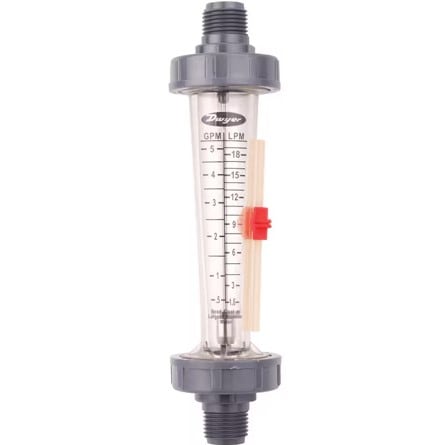
Series MM Mini-Master® Flowmeters
Series MM Mini-Master® Flowmeters provide compact, low-cost flow measurement for both gas and liquid applications. Constructed from transparent nylon for high chemical resistance, these precision-molded meters deliver excellent repeatability and visibility with a white-backed flow tube for clear float reading. The MMA model features a 2" scale with optional front-mounted valves, while the MMF offers a compact 1-1/2" scale ideal for small air volumes in medical, analytical, and cabinet purging systems.
Series 3100D Smart Differential Pressure Transmitter
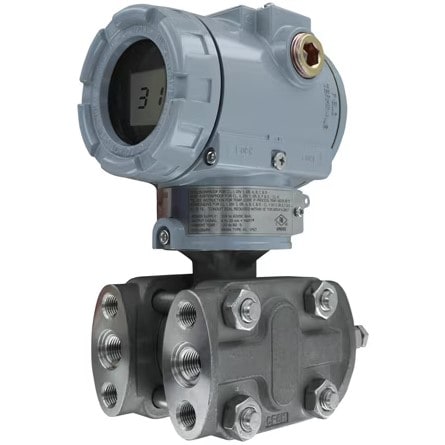
The Series 3100D Smart Differential Pressure Transmitter is a high-performance, microprocessor-based transmitter designed for differential pressure or level applications. It offers zero and span push-button calibration for fast setup without a field calibrator and supports full HART® communication. Featuring 100:1 rangeability, thermal compensation, and EEPROM data retention, the 3100D ensures accurate, reliable performance in critical process environments. FM approval allows safe use in hazardous (classified) locations, making it ideal for flow, level, and filter or pump differential pressure monitoring.
Series SFI-100 & SFI-300 Sight Flow Indicators
Series SFI-100 & SFI-300 Sight Flow Indicators provide a clear visual indication of liquid flow in hydraulic systems, pressure vessels, and coolant tanks. Available in brass or 316 stainless steel, these durable indicators feature threaded connections and single- or double-window designs with rotating impellers for quick flow verification. Removable windows allow easy maintenance and replacement, ensuring long service life in demanding industrial applications.
Temperature Monitoring Instruments
Thermal stability in subfab systems protects both process equipment and product yield. Monitoring ambient, air, and fluid temperatures helps ensure cooling performance and process uniformity across critical subsystems.
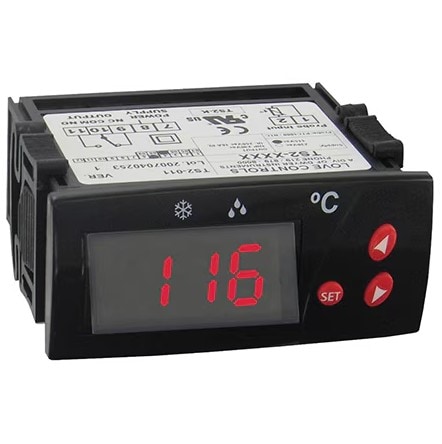
Series TS2 Digital Temperature Switch
The Series TS2 Digital Temperature Switch offers precise control of heating and cooling processes through a compact digital interface. Its bright LED display, simple configuration key, and SPDT relay output make it ideal for refrigeration, chiller, or thermal management applications in subfab and utility areas. The IP64 front panel ensures reliable operation in harsh or humid environments.
Series TE Duct & Immersion Temperature Sensor
Series TE Duct & Immersion Temperature Sensors are designed for accurate air and water temperature measurement, providing RTD or thermistor outputs for building automation systems. Duct sensors measure supply and return air, while immersion probes monitor hot or chilled water loops. Multiple housing and conduit options simplify installation throughout subfab infrastructure.
